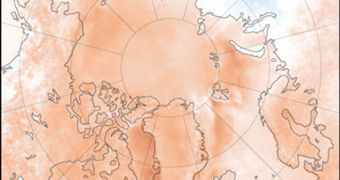Using historical meteorological data, other accounts and a natural climate “archive,” researchers investigating the evolution of the ice sheet between Greenland and the North European island archipelago of Svalbard have determined that the ice there is at its lowest in 800 years of tracked history. This proves once again that the global warming we are experiencing today is caused by humans, and not by the periodical cycles of our planet. Detailed explanations of the study appear in the latest issue of the scientific journal Climate Dynamics.
“We have combined information about the climate found in ice cores from an ice cap on Svalbard and from the annual growth rings of trees in Finland and this gave us a curve of the past climate. We see that the sea ice is shrinking to a level which has not been seen in more than 800 years,” University of Copenhagen Niels Bohr Institute Center for Ice and Climate Geophysicist Aslak Grinsted explains in a press release, quoted by LiveScience.
In addition to these sources, the authors say, the team also used a number of weather logs, obtained from ships that traveled to the area at various times in recent history. Harbor records were also employed, as they helped corroborate or disprove sailors' accounts of what the ice sheet looked like in the open sea. Despite having such vast documentation at their disposal, the investigators were aware of the fact that ice melting and re-freezing patterns were also influenced by a host of factors, including shifting wind patterns, ocean currents, as well as the amount of ice that formed or melted in previous years.
The study revealed that the Little Ice Age, which took place between 1700 and 1800, saw the largest ice extent in the entire time frame covered by the research. Conversely, the 13th and 20th centuries witnessed the lowest levels of sea ice, with modern times taking the cake, as far as low surfaces of cap ice go. Within a few decades, if not sooner, the North Pole, whose ice sheets are water-based, could melt completely during the summer, which would basically spell “death” for creatures such as polar bears, foxes, seals and hundreds of other species currently calling the Arctic “home.”

 14 DAY TRIAL //
14 DAY TRIAL //